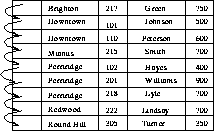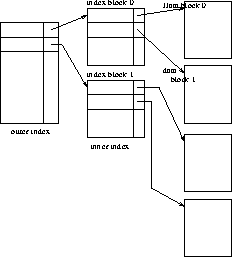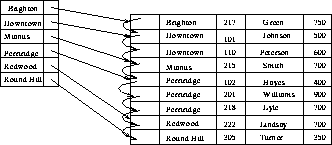- To get fast random access to records in a file, an index structure is used.
- Each index structure is associated with a particular search key.
- Text does not distinguish clearly between primary, secondary and clustering indices.
- We'll use definitions from Elmasri & Navathe ([ELNA89]).
- If the file is sequentially ordered on a primary key, an index on that key is called the primary index.
- An index on non-key attribute(s) the file is sorted on is called a clustering index.
- Indices on attributes the file is not sorted on are called secondary indices.
- Sequentially-ordered files having a primary index are called index-sequential files.
- Figure 8.1 shows a sequential file for deposit
records.

Figure 8.1: Sequential fiel for deposit records.
- Figures 8.2 and 8.3 show dense and
sparse indices for the deposit file.
- Notice how we would find records for Perryridge branch using both
methods. (Do it!)
- Dense indices faster in general.
- Sparse indices require less space.
- Sparse indices impose less maintenance for insertions and deletions. (Why?)
- Biggest cost is in bringing a block into main memory.
- We are guaranteed to have the correct block with this method, unless record is on an overflow block (actually could be several blocks).
- Index size still small.
- If there are no overflow blocks in the index, we can use binary search.
- This will read as many as
 blocks (as many as 7 for
our 100 blocks).
blocks (as many as 7 for
our 100 blocks).
- If index has overflow blocks, then sequential search typically used,
reading all
 index blocks.
index blocks.
- (Note: I think that some variation of binary search could be created for indices with overflow blocks. This would be faster than sequential search.)
- Solution: Construct a sparse index on the index
(Figure 8.4).

Figure 8.4: Two-level sparse index.
- Use binary search on outer index.
- Scan index block found until correct index record found.
- Use index record as before - scan block pointed to for desired record.
- For very large files, additional levels of indexing may be required.
- Indices must be updated at all levels when insertions or deletions require it.
- Frequently, each level of index corresponds to a unit of physical storage (e.g. indices at the level of track, cylinder and disk).
- Have to find the record
- If last record with a particular search key value, delete that search key value from index.
- For dense indices this is like deleting a record in a file.
- For sparse indices, delete a key value by replacing key value's entry in index by next search key value. If that value already has an index entry, delete the entry.
- Find place to insert.
- Dense index: insert search key value if not present.
- Sparse index: no change unless new block created.




